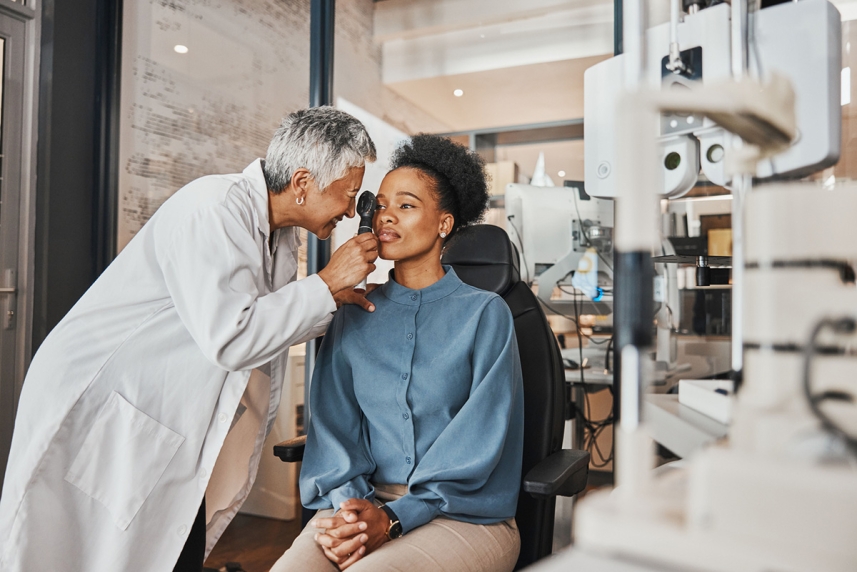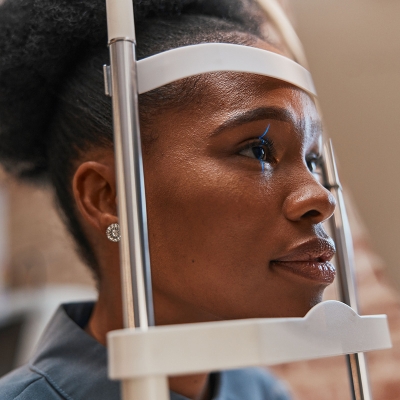What to expect before, during and after a contact lens exam or fitting
Need to update a contact lens prescription? Here’s what an eye care provider will need to do before a person can get one.

Once a year, people that wear contact lenses should go to their eye care provider to update their prescription.1 They’ll get their eyes examined and also have a contact lens exam or fitting to get their prescription updated — if necessary.
In addition to the initial contact lens fitting, they may need to book a follow-up visit, too. It’s a special visit where an eye care provider can make sure that the lenses fit right and comfortably after a person has worn the trial lenses for a certain period of time.
Let’s look at what happens before, during and after a contact lens exam or fitting. Also, what all the steps add up to for a contact lens wearer.
Your contacts and glasses may have different prescriptions, but you can find them both in the same convenient location. Shop now.
Why do contact lenses need different appointments than glasses?
Eye care providers treat contact lenses differently than glasses. Because contact lenses sit on the eyes, they’re considered a medical device. So, they need their own separate prescription.1
There’s more to them than just optical power, like a person’s glasses lenses that sit in front of the eyes and are held in place by those sturdy frames. Contact lenses are made from a bunch of different materials. They also come in different sizes and shapes.1
Additionally, contact lenses can be worn for different amounts of time. Some can be worn daily, while other pairs last for a week or even a month. So, there’s a lot more that an eye care provider must do to ensure contact lenses are right for a person.
What can a person expect during a contact lens exam?
A person will schedule a comprehensive eye exam to check their eye health and see if their vision has changed.2 If they wish to wear contact lenses (or already do so), they may need to schedule another appointment called a contact lens exam or fitting — or it may happen during the same visit.
During a contact lens exam, a person will get a series of tests done on their eyes. These will be to determine how the contact lens sit on the eye and what type might be best for a person.
This can include tests to:3
- Measure the size of the cornea and its curvature. This allows the eye care provider to figure out the right size and base curve of a person’s contact lenses. (The cornea is the see-through, dome-shaped outer layer of the eye.)
- Measure the size of the pupil (iris). That’s the black hole at the center of the eye that lets light get to the retina. This is important for people who wear hard contact lenses.
- Check a person’s tear film. This is a way to figure out how many tears are produced by a person’s eyes. For people who haven’t worn contact lenses before, this will be a way to see if they can successfully do so.
The reason: Dry eye can make it difficult for people to wear contact lenses. If a person’s eyes are too dry, their eye care provider might recommend not wearing contacts.
Let’s say a person’s contact lens exam happens on the same day as their comprehensive eye exam. If they’ve worn contact lenses before, they’ll likely get their contact lens prescription that day. They can then use it to buy their next supply of contact lenses.
But if they’re new to contact lenses, they may need to schedule a follow-up.
What happens during a new contact lens exam or fitting?
For new contact lens wearers, during a contact lens exam or fitting an eye care provider puts some trial contact lenses on a person’s eyes. This is to make sure they’re a good “fit.”
Eye care providers can also check:3
- Appearance and comfort of the lens on a person’s eye
- How sharp a person’s vision is wearing contact lenses (visual acuity)
A person’s eyes may not take to a certain type of contact lens. An eye care provider might need to test a few types before a person feels comfortable in them.
Also, a person wouldn’t want to buy a year’s supply of contact lenses that either don’t fit well or cause them discomfort. So, it’s important to get the fit right beforehand.
After a person’s fit is confirmed, their eye care provider will give them their contact lens prescription. This will include the information from the comprehensive eye exam and the contact lens exam.
For people new to contact lenses, their eye care provider might also talk to them about proper contact lens cleaning and safety. Practicing good contact lens hygiene can help people steer clear of eye infections. If left untreated, an eye infection can lead to long-term vision issues.
What happens after a contact lens fitting?
If a person is new to contact lenses, their eye care provider may have them book another follow-up visit. This will help the eye care provider check whether the contact lenses have caused any changes to the cornea.3
During the follow-up visit, an eye care provider can:
- Use a tool called a slit lamp to check the cornea and other eye tissue, close up. The eye care provider will be checking to see how the contact lenses align on the eye and how they’re fitting.
- Put some special eye drops in the eyes to check whether the contact lenses have damaged the corneas at all.
Besides these tests, an eye care provider only knows what a person tells them something’s off. So, it’s important for a person to tell their eye care provider if they’re experiencing any discomfort or redness in their eyes, for instance. This could be a sign that they need a new type of contact lens — or that they have an eye infection.
Where can someone buy contact lenses?
Now that a person has their contact lens prescription (and best fit), it’s time to order a supply of contact lenses. That could be 6 months or a full year’s worth — whatever a person is comfortable with.
Where a person buys their contact lenses depends on what brand and type their eye care provider recommended. Members can do searches based on:
- Brand
- Lens type
- Prescription type
You can order contact lenses online through uhcglasses.com to save 10% and get free shipping on orders over $99.
Sources:
- Healthy vision and contact lenses American Optometric Association
- Comprehensive eye exams American Optometric Association
- The contact lens exam Optometrists Network


